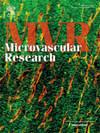Pilot study on near-infrared spectroscopy in peripheral artery disease: Differentiating upper and lower limbs and its correlation with the ankle-brachial index
IF 2.7
4区 医学
Q2 PERIPHERAL VASCULAR DISEASE
引用次数: 0
Abstract
Peripheral artery disease (PAD) is a global health challenge, with current diagnostic methods, including the ankle-brachial index (ABI), having limitations, particularly in patients with arterial calcification. Near-infrared spectroscopy (NIRS) offers potential advantages as a non-invasive assessment tool, yet its clinical utility in PAD remains underexplored. This pilot study evaluated NIRS for differentiating between non-ischemic upper limbs and ischemic lower limbs, and assessed NIRS correlation with ABI. To do that, we performed an observational, cross-sectional study employing a convenience sample of 51 patients with PAD attending the vascular surgery outpatient clinic. A portable spectrometer recorded NIRS measurements from the right thumb and both halluces at rest. Random Forest classification was implemented to differentiate upper and lower limbs, revealing distinct NIRS patterns between upper and lower limbs, with an area under the ROC curve of 0.91 (95 % CI 0.88–0.94). Interval Partial Least Squares regression (iPLS) identified wavelength regions correlating with ABI, with the 1429–1463 nm interval being the most informative for ABI prediction, with a modest correlation (R2 = 0.167, RMSECV = 0.186).
NIRS demonstrated strong discriminative capability between non-ischemic upper and ischemic lower limbs in PAD. While the correlation between NIRS and ABI was modest, it suggests potential clinical relevance. These findings indicate that NIRS could be a rapid, portable, non-invasive complementary tool for PAD assessment.
近红外光谱在外周动脉疾病中的初步研究:上肢和下肢的鉴别及其与踝肱指数的相关性
外周动脉疾病(PAD)是一个全球性的健康挑战,目前的诊断方法,包括踝肱指数(ABI),具有局限性,特别是在动脉钙化患者中。近红外光谱(NIRS)作为一种非侵入性评估工具具有潜在的优势,但其在PAD中的临床应用仍未得到充分探索。本初步研究评估了NIRS用于区分非缺血上肢和缺血下肢,并评估了NIRS与ABI的相关性。为了做到这一点,我们进行了一项观察性横断面研究,采用51例在血管外科门诊就诊的PAD患者作为方便样本。一台便携式光谱仪记录了右拇指和两个幻觉在休息时的近红外光谱测量值。采用随机森林分类对上肢和下肢进行区分,上肢和下肢的NIRS模式明显,ROC曲线下面积为0.91 (95% CI 0.88-0.94)。区间偏最小二乘回归(iPLS)确定了与ABI相关的波长区域,其中1429-1463 nm区间对ABI预测的信息最丰富,相关性不大(R2 = 0.167, RMSECV = 0.186)。近红外光谱对非缺血性上肢和缺血性下肢有较强的区分能力。虽然NIRS和ABI之间的相关性不大,但它表明了潜在的临床相关性。这些发现表明,近红外光谱可能是一种快速、便携、无创的PAD评估补充工具。
本文章由计算机程序翻译,如有差异,请以英文原文为准。
求助全文
约1分钟内获得全文
求助全文
来源期刊

Microvascular research
医学-外周血管病
CiteScore
6.00
自引率
3.20%
发文量
158
审稿时长
43 days
期刊介绍:
Microvascular Research is dedicated to the dissemination of fundamental information related to the microvascular field. Full-length articles presenting the results of original research and brief communications are featured.
Research Areas include:
• Angiogenesis
• Biochemistry
• Bioengineering
• Biomathematics
• Biophysics
• Cancer
• Circulatory homeostasis
• Comparative physiology
• Drug delivery
• Neuropharmacology
• Microvascular pathology
• Rheology
• Tissue Engineering.
 求助内容:
求助内容: 应助结果提醒方式:
应助结果提醒方式:


